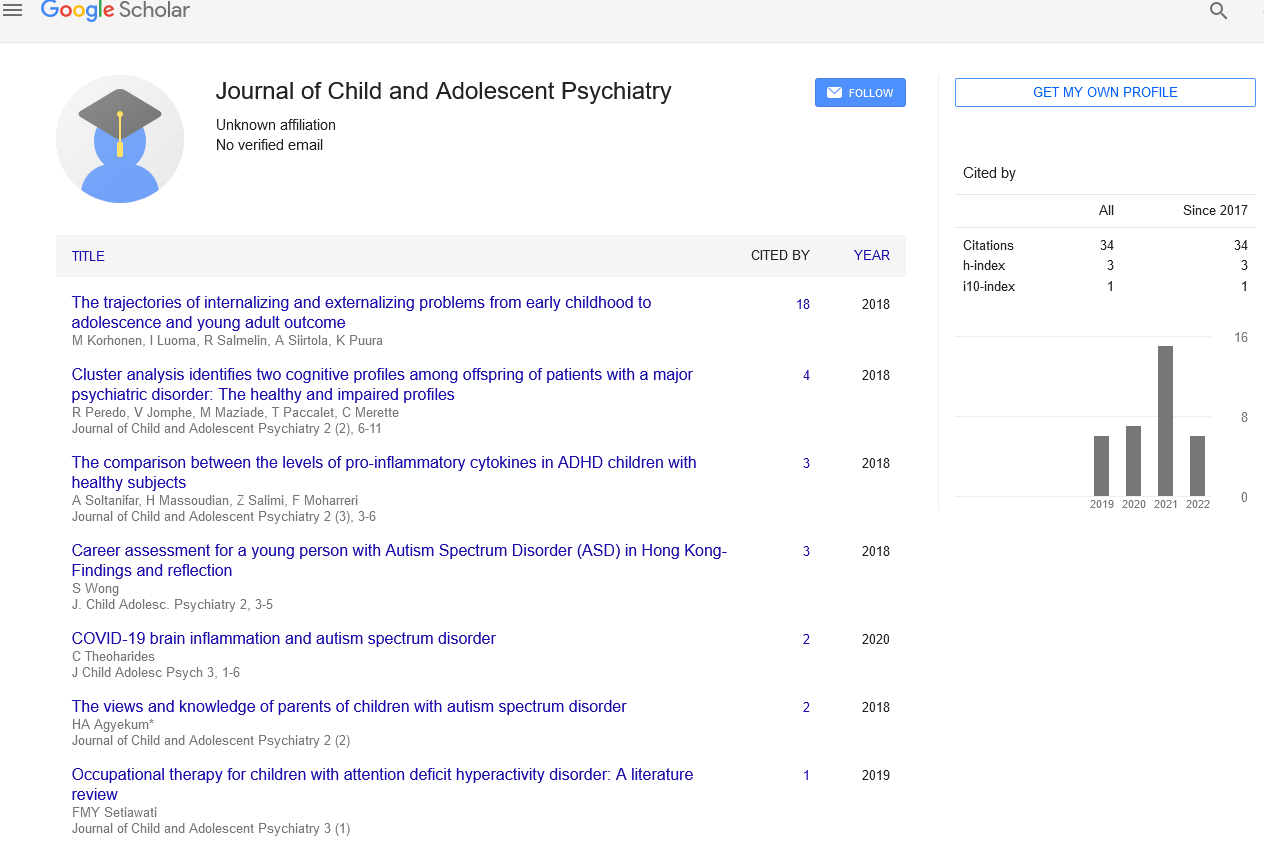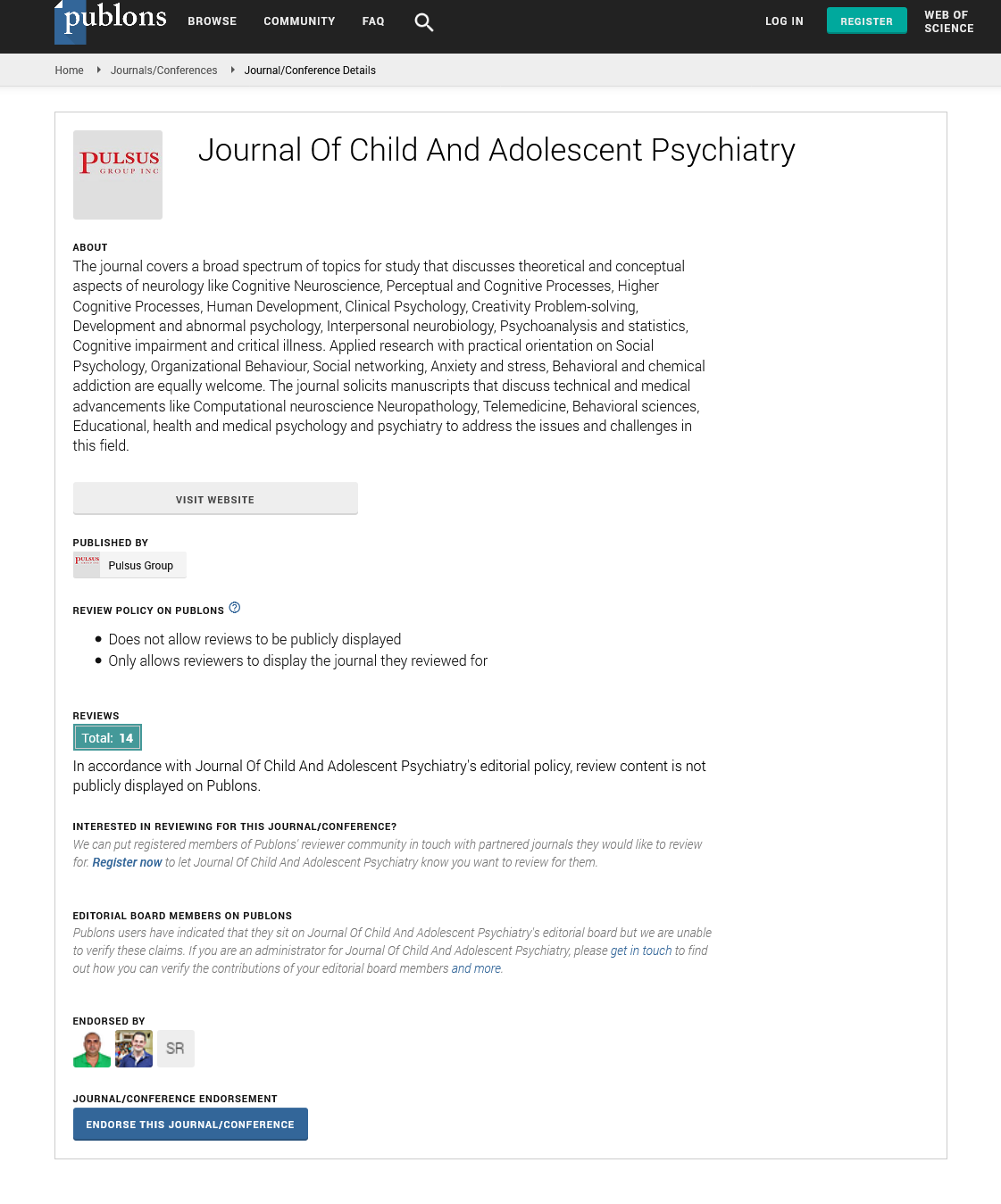Disorder in children
Received: 04-May-2022, Manuscript No. PULJCAP-22-5041; Editor assigned: 12-May-2022, Pre QC No. PULJCAP-22-5041(PQ); Accepted Date: May 20, 2022; Reviewed: 14-May-2022 QC No. PULJCAP-22-5041(Q); Revised: 16-May-2022, Manuscript No. PULJCAP-22-5041(R); Published: 24-May-2022, DOI: 10.37532/puljcap.2022.6(3);26-27
This open-access article is distributed under the terms of the Creative Commons Attribution Non-Commercial License (CC BY-NC) (http://creativecommons.org/licenses/by-nc/4.0/), which permits reuse, distribution and reproduction of the article, provided that the original work is properly cited and the reuse is restricted to noncommercial purposes. For commercial reuse, contact reprints@pulsus.com
Keywords
Functional motion disorders
Introduction
Functional Motion Disorders (FMDs) are a part of the large spectrum of purposeful Neurological Disorders (NDs). Previously, FMDs represented an analysis of exclusion, however, can now be diagnosed in an inclusionary way with the use of phenomenological manifestations which are precise to them without reliance on the presence or absence of mental stressors or suggestive ancient clues. The different period this is interchangeably used for FNDs withinside the vintage literature consists of hysteria, conversion disorder, psychogenic disorder, non-organic, and dissociative disorder. Although hysteria become first defined in youngsters via way of means of Ranvlin in 1748, it become persevered to be believed as “now no longer an ailment of childhood, however one that is on occasion visible in early life”. But later withinside the 1850s, Briquet confirmed that it did arise in youngsters, and as often as in adults . FMDs in youngsters and adults percentage a few, not unusual place functions however they're certain to have a few variations as nicely due to the fact the age at onset has to bear at the threat factors, the phenomenology of odd motion, and reaction to specific remedy modalities. The understanding of those variations can assist to enhance our knowledge of the pathogenesis of FMDs. Most of the present literature on FMDs relates to adults only, so there's a paucity of statistics in the literature describing the epidemiology, phenomenology, threat factors, management, and analysis of FMDs amongst youngsters. In this review, we aimed to discuss these aspects of FMDs in children.
The frequency of FMDs amongst youngsters evaluated in motion sickness clinics tiers among 2% and 3% in distinctive research . In a have a look performed by Kozlowska et al., FMDs contributed to 17% of the conversion sickness instances in youngsters. Most of the research confirmed a better occurrence of FMDs amongst women compared to boys with a ratio of 3-4:1 which is much like the person data. The genuine mechanism of this intercourse predilection of FMDs continues to be now no longer regarded due to the complicated interplay of social, cultural, and organic factors .FMDs in youngsters tend to have abrupt onset compared to adults and account for 4%-23% of the intense motion disorders. In such instances, records of psychopathology are frequently absent or misleading, because the emergency room isn't an excellent place for eliciting records associated with the psychosocial stressor and a radical assessment with standardized questionnaires is likewise on occasion now no longer feasible . However, a cautious medical exam can assist in making the early analysis of FMDs in youngsters.
It has been proposed that FMDs sufferers can be primed through numerous disturbing occasions at some point of early formative years along with emotional, physical, and sexual abuse with next precipitating elements triggering extraordinary movements. Kozlowska et al. hypothesized that kids with conversion disorders, together with FMDs are in all likelihood to have a better price of unresolved loss and trauma, thoughts, feelings, and reminiscences approximately precise existence occasions. These beyond unresolved occasions function emotionally charged cloth that has the ability to precipitate FMDs beneathneath the affect of effective emotional triggers . A current look at additionally proven that formative years abuse burden is related to left anterior insular extent discount in FND sufferers. Thus it's been hypothesized that negative existence occasions can also additionally have an effect on developmentally prone neural circuits main to aberrant neuroplastic modifications which later allows extended predilection for FMDs. However, some other current look at observed that annoying existence occasions and maltreatment are notably greater not unusualplace in humans with FND than in healthful controls and affected person controls, however many instances record no stressors. Thus, now no longer all FMDs sufferers have a records of stressors or trauma, and now no longer all kids who're uncovered to these stressors develop FMDs Clinicians regularly bear in mind FMDs as a “prognosis of exclusion,” now no longer to be normal till all different capacity natural reasons were exhaustively dominated out, especially withinside the pediatric age group. However, the current DSM-five standards confused at the demonstration of wonderful symptoms. Therefore, clinicians have to be recommended to make a phenotype-particular prognosis. At the equal time, it have to now no longer be made truely due to the presence of uncommon sympt--oms, or the records of a stressor or previous psychiatric illness, or paintings up for the natural motive is normal. Few natural motion problems of youth can mimic FMDs as they'll showcase one or greater of the above-referred to functions main to misdiagnosis of FMDs, for example, paroxysmal dyskinesias, episodic ataxias, rapid-onset dystoniaparkinsonism, acute drug-brought on dystonia, task-particular dystonia, dopa-responsive dystonia, and Tourette`s syndrome. While a few natural illnesses can gift with psychiatric manifestations first and motion problems later together with Huntington's disease, Wilson's disease, and dentatorubropallidoluysian atrophy.






